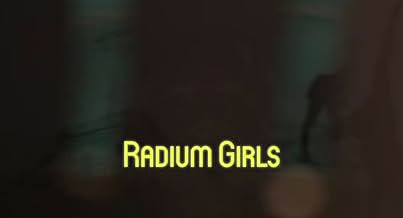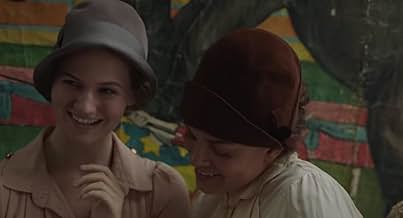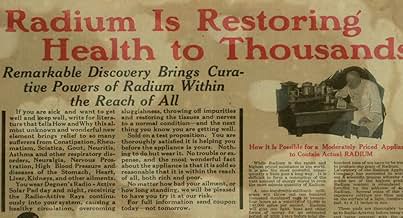PUNTUACIÓN EN IMDb
6,3/10
2,6 mil
TU PUNTUACIÓN
En la década de 1920, un grupo de trabajadoras protesta para obtener condiciones de trabajo seguras cuando varias de ellas enferman a causa de su exposición al radio en la fábrica en la que ... Leer todoEn la década de 1920, un grupo de trabajadoras protesta para obtener condiciones de trabajo seguras cuando varias de ellas enferman a causa de su exposición al radio en la fábrica en la que trabajan.En la década de 1920, un grupo de trabajadoras protesta para obtener condiciones de trabajo seguras cuando varias de ellas enferman a causa de su exposición al radio en la fábrica en la que trabajan.
- Dirección
- Guión
- Reparto principal
- Premios
- 2 premios y 2 nominaciones en total
Reseñas destacadas
They managed to take a piece of women's history and make it dull. Read the book.
Greetings again from the darkness. A huckster or carnival barker is spouting off the many uses and health benefits of radium. He even hails it as "liquid sunshine". That's how this film from co-directors Lydia Dean Pilcher (A CALL TO SPY, 2020) and Ginny Mohler kicks off. Ms. Mohler co-wrote the screenplay with Brittany Shaw, and it's presented as a historical dramatization - some of the names have been changed to protect both the innocent and guilty.
Joey King ("Fargo") stars as Bessie, younger sister to Josephine (Abby Quinn, I'M THINKING OF ENDING THINGS). Josephine is the more studious of the two, as Bessie dreams of becoming a Hollywood star. Both girls work as dial painters at American Radium (re-named from the actual United States Radium Corporation). Josephine wins awards for being the most productive, while Bessie gets scolded and has her pay docked due to shoddy work. See, Bessie refuses to lick the brush to create the fine tip needed for precise work. So what's a dial painter? Well, it's 1925, and these women are applying a radioactive liquid to the faces of watches to create the popular glow-in-the-dark effect. Marie Curie's discovery from twenty years prior has been found to have many uses, including shrinking cancerous tumors. However, the story finds the dial painters who lick-dip-paint, are getting sick and dying at an ever-increasing rate.
Mary, older sister to Bessie and Josephine and also a dial painter, had previously died after being diagnosed with syphilis. Bessie's outrage and curiosity starts to build when the company doctor passes along the same diagnosis to (virgin) sister Josephine when her teeth start falling out, her joints ache, and her skin breaks out in a rash. We witness the transformation of Bessie from teenybopper to activist. She's helped along by love interest Walt (Collin Kelly-Sordelet) who introduces her to the socialist movement, as well as Wiley Stephens (Cara Seymour, "The Knick"), the real life founder of the Consumers League.
Many dial painters refused to believe the connection and were frightened to lose their job. A few came forward, though they struggled to find a legal counsel willing to go against the giant corporation led by the arrogant Mr. Roeder (John Bedford Lloyd). It's interesting to see the pieces come together for the 1928 court case. Another real life player in this chain of events was Dr Katherine Drinker (played her by Veanne Cox), the scientist who conducted the confidential study that concluded radium produced harsh effects, including physical deterioration - just as Josephine has experienced.
The courtroom scenes may not have the dramatic impact that we are accustomed to seeing in cinema, but this is a remarkable story of some incredibly strong women who stood up, not just for themselves, but for those who wouldn't or couldn't come forward. Their court case led to changes in workplace safety laws, while also reminding us of an era when women were given so little power, and giant corporations and the government ruled the roost and couldn't be trusted. The filmmakers blend some vintage clips throughout, and use the discovery of King Tut's tomb only three years prior to give the feel of this era nearly 100 years past. Rosamund Pike starred as Marie Curie in RADIOACTIVE earlier this year, and there have been a couple of books written on this topic: "The Radium Girls: The Dark Story of America's Shining Women" by Kate Moore (2016), and "Radium Girls: A Play in Two Acts" by DW Gregory (2000). It's a story of courageous women that deserves a wider audience.
Joey King ("Fargo") stars as Bessie, younger sister to Josephine (Abby Quinn, I'M THINKING OF ENDING THINGS). Josephine is the more studious of the two, as Bessie dreams of becoming a Hollywood star. Both girls work as dial painters at American Radium (re-named from the actual United States Radium Corporation). Josephine wins awards for being the most productive, while Bessie gets scolded and has her pay docked due to shoddy work. See, Bessie refuses to lick the brush to create the fine tip needed for precise work. So what's a dial painter? Well, it's 1925, and these women are applying a radioactive liquid to the faces of watches to create the popular glow-in-the-dark effect. Marie Curie's discovery from twenty years prior has been found to have many uses, including shrinking cancerous tumors. However, the story finds the dial painters who lick-dip-paint, are getting sick and dying at an ever-increasing rate.
Mary, older sister to Bessie and Josephine and also a dial painter, had previously died after being diagnosed with syphilis. Bessie's outrage and curiosity starts to build when the company doctor passes along the same diagnosis to (virgin) sister Josephine when her teeth start falling out, her joints ache, and her skin breaks out in a rash. We witness the transformation of Bessie from teenybopper to activist. She's helped along by love interest Walt (Collin Kelly-Sordelet) who introduces her to the socialist movement, as well as Wiley Stephens (Cara Seymour, "The Knick"), the real life founder of the Consumers League.
Many dial painters refused to believe the connection and were frightened to lose their job. A few came forward, though they struggled to find a legal counsel willing to go against the giant corporation led by the arrogant Mr. Roeder (John Bedford Lloyd). It's interesting to see the pieces come together for the 1928 court case. Another real life player in this chain of events was Dr Katherine Drinker (played her by Veanne Cox), the scientist who conducted the confidential study that concluded radium produced harsh effects, including physical deterioration - just as Josephine has experienced.
The courtroom scenes may not have the dramatic impact that we are accustomed to seeing in cinema, but this is a remarkable story of some incredibly strong women who stood up, not just for themselves, but for those who wouldn't or couldn't come forward. Their court case led to changes in workplace safety laws, while also reminding us of an era when women were given so little power, and giant corporations and the government ruled the roost and couldn't be trusted. The filmmakers blend some vintage clips throughout, and use the discovery of King Tut's tomb only three years prior to give the feel of this era nearly 100 years past. Rosamund Pike starred as Marie Curie in RADIOACTIVE earlier this year, and there have been a couple of books written on this topic: "The Radium Girls: The Dark Story of America's Shining Women" by Kate Moore (2016), and "Radium Girls: A Play in Two Acts" by DW Gregory (2000). It's a story of courageous women that deserves a wider audience.
This movie has a good message but it was super boring. I get that this is a historical film, but they could've showed the story from a global scale instead of only focusing on a few characters. As tragic as this story is, I felt little to no emotion for the underdeveloped characters. There was also little scientific evidence revealed, and maybe that's historically accurate, but I just felt like nothing really happened? And I even felt like there wasn't a solution in the end. It was disappointing because I was expecting a more factual storyline with interesting historical details that I didn't know about, but I learned nothing except for the fact that many girls died from unsafe work conditions, which I had already known from the trailer. Instead, I watched a very emotional main character break down from watching her loved ones slowly die.
I must admit that I was expecting much more from the 2018 movie titled "Radium Girls" than what writers Ginny Mohler and Brittany Shaw managed to deliver. Why? Well, because of the subject and topic of the storyline and its importance in real life and the lives of those girls working in the Radium business.
This is indeed a very tragic story, but for some reason directors Lydia Dean Pilcher and Ginny Mohler managed to deliver the storyline and its contents in a somewhat disappointing manner, and I must say that I was left with an overwhelming sensation of "was that really it?". This movie's story holds such a significant tale and importance that it felt that directors Lydia Dean Pilcher and Ginny Mohler just nonchalantly brushed over the topic without delving properly into the contents and putting to the screen the tragedy and the horror of these real life events.
The pacing of the storyline felt, oddly enough, monotonous and never really managed to capture me entirely. Sure, the movie was watchable, but it just felt too shallow and bland, to be bluntly honest.
"Radium Girls" was gifted with a rather good ensemble of actors and actresses, and while they had precious little to work with in terms of a proper script and dialogue, then the actors and actresses did manage to put on good enough performances, enough so to make the movie watchable.
I was disappointed with the contents of this 2018 movie as it came to an end. And as such, I am rating the movie a mediocre five out of ten stars. This was hardly a sufficient manner to shed light upon one of the most ghastly real life horror stories of American industry.
This is indeed a very tragic story, but for some reason directors Lydia Dean Pilcher and Ginny Mohler managed to deliver the storyline and its contents in a somewhat disappointing manner, and I must say that I was left with an overwhelming sensation of "was that really it?". This movie's story holds such a significant tale and importance that it felt that directors Lydia Dean Pilcher and Ginny Mohler just nonchalantly brushed over the topic without delving properly into the contents and putting to the screen the tragedy and the horror of these real life events.
The pacing of the storyline felt, oddly enough, monotonous and never really managed to capture me entirely. Sure, the movie was watchable, but it just felt too shallow and bland, to be bluntly honest.
"Radium Girls" was gifted with a rather good ensemble of actors and actresses, and while they had precious little to work with in terms of a proper script and dialogue, then the actors and actresses did manage to put on good enough performances, enough so to make the movie watchable.
I was disappointed with the contents of this 2018 movie as it came to an end. And as such, I am rating the movie a mediocre five out of ten stars. This was hardly a sufficient manner to shed light upon one of the most ghastly real life horror stories of American industry.
Such a potentially interesting story wasted on insipid dialog and poor plot development. I love a good looking historical film, but could the makers have devoted a little more time to the details? 50-star American flags, 1940s swing music and 1980s ties and sweaters - - - in 1926? I'm sorry, Bessie could not have spoken Valley Girl in the 20s.
The cutaways to vintage film and newsreel scenes could have been a novel way to establish historical context, but too many of the clips were only weakly related to the subject matter.
The cutaways to vintage film and newsreel scenes could have been a novel way to establish historical context, but too many of the clips were only weakly related to the subject matter.
¿Sabías que...?
- CuriosidadesRadon, a Radium decay product, kills over 21,000 Americans every year according to the US EPA.
- PifiasAt a little after 1 hour into the film there is a 50 star USA flag fluttering in the wind. In the 1920s there would have been only 48 stars on the US flag.
Selecciones populares
Inicia sesión para calificar y añadir a tu lista para recibir recomendaciones personalizadas
- How long is Radium Girls?Con tecnología de Alexa
Detalles
- Fecha de lanzamiento
- País de origen
- Idioma
- Títulos en diferentes países
- Радиевые девушки
- Localizaciones del rodaje
- Empresas productoras
- Ver más compañías en los créditos en IMDbPro
- Duración1 hora 42 minutos
- Color
Contribuir a esta página
Sugerir un cambio o añadir el contenido que falta





































